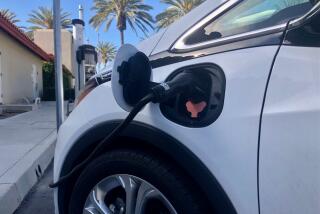Your reasoning may vary
- Share via
SAVVY CAR BUYERS ALWAYS check out the federally rated gas mileage for the models they’re considering -- and then snigger knowingly. The ratings are generally fine for figuring out whether a car is a major gas guzzler, but when it comes to real-life fuel economy, the small-print caveat emptor of the automotive
industry is “Actual mileage may vary.”
Vary it does. According to tests run by Consumer’s Union last year, the miles-per-gallon numbers on new-car stickers are often wildly optimistic -- giving cars as much as twice the estimated gas mileage they’re likely to get. So the Environmental Protection Agency’s new plan for gauging fuel economy, starting next year, is most welcome.
And overdue. The EPA hasn’t updated the methods it uses to measure gas mileage since the 1970s, when Americans’ driving habits were as different from today’s as Birkenstocks are from Manolo Blahniks. Three decades ago, U.S. motorists crawled along the freeways at a gas-saving maximum of 55 mph. Fuel-consuming air conditioning was a luxury, not a standard feature, and was not included in the tests. Traffic was lighter.
For that matter, the tests never involved hopping into a car with a full tank of gas and seeing how far it could go. Instead, and to this day, automakers test handmade prototype cars in laboratories, measuring the exhaust as they tinker with the engine’s revolutions per minute. That part won’t change.
But the new system, when it takes effect next year with the 2008 model cars, should help motorists make a more realistic decision on how many of those $3.49 gallons of regular unleaded they’ll have to buy.
Strange to say, these new gas-mileage figures will not require automakers to improve the actual fuel economy of cars. Theoretically, it should. The required average for passenger cars is 27.5 mpg -- the same as it was in the 1970s. But when cars undergo the new tests, cars that used to measure 27.5 mpg now will be rated at more like 25 mpg, perhaps less.
Even so, car companies will get full credit for meeting standards even when they’re not. (The EPA ratings will be considered an “adjustment” that the federal Department of Transportation, which oversees automakers’ fuel-economy standards, doesn’t have to take into account.) Consumers will know better, and that should help. But the fuel-economy standards are as outdated as the EPA’s old method of calculating gas mileage. It’s past time to update them -- and base them on the gas mileage cars really get.






